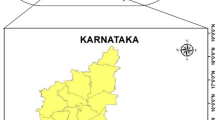Abstract
The estimation of evaporation has been under surveillance, which is being carried out by many researchers toward applications in the fields related to hydrology and water resources management. Due to complexities associated with its estimation, research has employed several modes via direct and indirect methods to estimate. Accurate estimations are still the thrust area of research in these fields. The pan evaporation estimations with the help of data modeling techniques have provided better results in the recent past. The advancement in the field of data modeling has introduced several techniques which can best fit the data type and provide accurate estimations. The novel gamma test (GT) was used to decide the best input–output combination. Parameter optimization was carried out by grid search. The developed models gave better estimations of pan evaporation, but exhibited some limitations with nonlinearity, and sparse and noisy data. These limitations paved way for data pre-processing techniques such as wavelet transform. This study made an attempt to explore hybrid modeling using discrete wavelet transform (DWT) and support vector machines (SVR) for pan evaporation estimation. Two stations representing contrasting climatic zones namely ‘Bajpe’ and ‘Bangalore’ located in the state of Karnataka, India, are selected in this study. The meteorological datasets recorded at these stations are analyzed using gamma test and grid search to use the best input–output combinations for the models. The modeled pan evaporation estimations are very promising toward ever demanding accuracy expected in the associated fields.







Similar content being viewed by others
References
Adamowski J, Adamowski K (2008) Development of a real-time river flood forecasting transfer function-noise model with a Kalman filter for snowmelt driven floods. J Environ Hydrol 16:1–11
Burt CM, Mutziger AJ, Allen RG, Howell TA (2005) Evaporation research: review and interpretation. J Irrig Drain Eng 131(1):37. doi:10.1061/(ASCE)0733-9437
Cortes C, Vapnik V (1995) Support vector networks. Machine Learn 20:273–297
Deswal S, Pal M (2008) Artificial neural network based modeling of evaporation losses in reservoirs. Int J Math Phys Eng Sci 39(3):177–181
Drucker H, Wu D, Vapnik VN (1999) Support vector machines for spam categorization. IEEE Trans Neural Netw 10:1048–1054
Espinoza F, Minsker B, Goldberg D (2005) Adaptive hybrid genetic algorithm for groundwater remediation design. J Water Resour Plan Manag 131(1):14–24. doi:10.1061/(ASCE)0733-9496(2005)
Finch J, Calver A. (2008) Methods for the quantification of evaporation from lakes. http://nora.nerc.ac.uk/14359
Guimarães Santos CA, Silva GBL (2014) Daily streamflow forecasting using a wavelet transform and artificial neural network hybrid models. Hydrol Sci J 59(2):312–324. doi:10.1080/02626667.2013.800944
Jain SK, Nayak PC, Sudheer KP (2008) Models for estimating evapotranspiration using artificial neural networks and their physical interpretation. Hydrol Process 22:2225–2234. doi:10.1002/hyp
Jones A (2004) New tools in non-linear modelling and prediction. CMS 1(2):109–149
Jothiprakash V, Kote AS (2011) Improving the performance of data-driven techniques through data pre-processing for modelling daily reservoir inflow. Hydrol Sci J 56(1):168–186. doi:10.1080/02626667.2010.546358
Kaheil YH, Rosero E, Gill MK, McKee M, Bastidas LA (2008) Downscaling and forecasting of evapotranspiration using a synthetic model of wavelets and support vector machines. IEEE Trans Geosci Remote Sens 46(9):2692–2707
Kim S, Shiri J, Kisi O (2012) Pan evaporation modeling using neural computing approach for different climatic zones. Water Resour Manag 26(11):3231–3249. doi:10.1007/s11269-012-0069-2
Kumar DN, Reddy MJ, Maity R (2007) Regional rainfall forecasting using large scale climate teleconnections and artificial intelligence techniques. J Intell Syst 16(4):307–322. doi:10.1515/JISYS.2007.16.4.307
Nourani V, Sayyah FM (2012) Sensitivity analysis of the artificial neural network outputs in simulation of the evaporation process at different climatologic regimes. Adv Eng Softw 47(1):127–146. doi:10.1016/j.advengsoft.2011.12.014
Raghavendra NS, Deka PC (2014) Support vector machine applications in the field of hydrology: a review. Appl Soft Comput 19:372–386. doi:10.1016/j.asoc.2014.02.002
Ramachandra TV, Kamakshi G, Shruthi BV (2004) Bioresource status in Karnataka. Renew Sustain Energy Rev 8:1–47. doi:10.1016/j.rser.2003.09.001
Tabari H, Kisi O, Ezani A, Hosseinzadeh TP (2012) SVM, ANFIS, regression and climate based models for reference evapotranspiration modeling using limited climatic data in a semi-arid highland environment. J Hydrol 444–445:78–89. doi:10.1016/j.jhydrol.2012.04.007
Vapnik VN (1995) The nature of statistical learning theory, vol 8. Springer, Verlag. doi:10.1109/TNN.1997.641482
Xu CY, Singh VP (2001) Evaluation and generalization of temperature-based methods for calculating evaporation. Hydrol Process 15:305–319. doi:10.1002/hyp.11
Acknowledgement
The authors are grateful to Engineer in-charge and staff members of meteorological station near Bajpe for their courtesy to provide access to data for the research work.
Author information
Authors and Affiliations
Corresponding author
Rights and permissions
About this article
Cite this article
Pammar, L., Deka, P.C. Daily pan evaporation modeling in climatically contrasting zones with hybridization of wavelet transform and support vector machines. Paddy Water Environ 15, 711–722 (2017). https://doi.org/10.1007/s10333-016-0571-x
Received:
Revised:
Accepted:
Published:
Issue Date:
DOI: https://doi.org/10.1007/s10333-016-0571-x




